Health-Conscious Energy Management for Fuel Cell Hybrid Electric Vehicles Based on Adaptive Equivalent Consumption Minimization Strategy
Abstract
:Featured Application
Abstract
1. Introduction
- The performance degradation of the fuel cell and battery was incorporated into the optimization objective of the A-ECMS to achieve a balance between the fuel economy and the energy source lifetime.
- An optimal covariate predictor based on an LSTM neural network was proposed, which enabled the equivalence factors of the ECMS to vary in real time under operating conditions.
- Performance degradation indices of the fuel cell and battery were selected, and the corresponding performance degradation models were developed.
2. Fuel Cell Hybrid Electric Vehicles Modeling
2.1. Vehicle Dynamics Model
2.2. Fuel Cell Model
2.3. Battery Model
2.4. Driving Motor Model
3. Energy Management Strategy of FCHEV
3.1. Speed Prediction
- (1)
- Various driving conditions were combined to build a database of historical speed samples. The historical N s speed samples were selected in a sliding window and the acceleration corresponding to the vehicle speed at the current moment was introduced as a characteristic parameter to build the input and the output vectors :
- (2)
- The size of the training sample data set was S. The sliding step was set to 1 s, and the model selected the first N s historical speed data of the training sample database to train based on the sliding step. The model training sample input matrix and output matrix were then obtained:
- (3)
- After the training of the LSTM speed prediction model was complete, the first N s historical speed data in the test sample database were selected as the sliding window, and the historical speed data were input into the trained model according to the input matrix of the test sample to predict the speed 1 s in the future. At this time, the sliding window was shifted to the right in accordance with the step length, and the 1 s speed data obtained from the prediction was added to the right side of the sliding window to form a new input, which was then input into the model to predict the speed 2 s in the future. The above operation was repeated to realize the multi-step prediction of the future speed.
3.2. Optimal Covariate Predictor Based on Long Short-Term Memory Neural Network
3.2.1. Optimal Covariate Database Based on PMP
- (1)
- must be obtained such that the Hamiltonian function achieves the minimum of all values within the time boundaries, as follows:
- (2)
- The optimal state variable equation is obtained by partial differentiation of the covariate in the Hamiltonian function, as follows:
3.2.2. Optimal Covariate Predictor
3.3. DA-ECMS
4. Simulation Results and Discussion
4.1. Result of Optimal Covariate Prediction
4.2. Comparative Validation of DA-ECMS
5. Hardware-in-the-Loop Validation
6. Conclusions
Author Contributions
Funding
Data Availability Statement
Conflicts of Interest
List of Nomenclature
| FCHEV | fuel cell hybrid electric vehicle | activation energy | |
| EMS | energy management strategy | temperature in Celsius | |
| ECMS | equivalent consumption minimization strategy | Ah | Ah-throughput |
| PEMFC | proton exchange membrane fuel cell | power law factor | |
| LSTM | long short-term memory | SOC-related coefficient | |
| SOC | state of charge | SOC-related coefficient | |
| traction force | charge/discharge rate | ||
| f | rolling resistance coefficient | motor power | |
| m | mass of FCHEV | motor torque | |
| angle of road slope | motor speed | ||
| A | frontal area | motor efficiency | |
| CD | drag coefficient | fuel cell instantaneous hydrogen consumption | |
| vehicle rotational mass conversion coefficient | power demand | ||
| velocity | B | pre-exponential factor | |
| g | gravitational constant | battery hydrogen consumption | |
| powertrain power demand | covariate | ||
| fuel cell stack output power | current | ||
| output power of battery | equivalence factor | ||
| unidirectional DC/DC converter efficiency | R | internal resistance | |
| bidirectional DC/DC converter efficiency | degradation loss voltage | ||
| single fuel cell output voltage | activation loss | ||
| theoretical thermodynamic electric potential | ohmic loss | ||
| reference potential per unit of activity | concentration loss | ||
| other component power loss | F | Faraday constant | |
| fuel cell hydrogen consumption rate | R0 | gas molar constant | |
| hydrogen molar mass | P | total pressure in pile | |
| LHV | hydrogen low heating value | partial pressure of hydrogen | |
| voltage degradation of single fuel cell | partial pressure of oxygen | ||
| battery instantaneous consumption rate | partial pressure of water vapor | ||
| battery output power | fuel cell stack output power | ||
| instantaneous total hydrogen consumption rate | N | number of single cells | |
| open-circuit voltage | single cell current | ||
| fuel cell instantaneous hydrogen consumption rate | fuel cell system net output power | ||
| air compressor power loss | |||
| initial value of SOC | battery capacity loss | ||
| nominal battery capacity |
References
- Olabi, A.G.; Wilberforce, T.; Abdelkareem, M.A. Fuel cell application in the automotive industry and future perspective. Energy 2021, 214, 118955. [Google Scholar] [CrossRef]
- Ramadhani, F.; Hussain, M.A.; Mokhlis, H.; Fazly, M.; Ali, J.M. Evaluation of solid oxide fuel cell based polygeneration system in residential areas integrating with electric charging and hydrogen fueling stations for vehicles. Appl. Energy 2019, 238, 1373–1388. [Google Scholar] [CrossRef]
- Chen, K.; Laghrouche, S.; Djerdir, A. Fuel cell health prognosis using unscented Kalman filter, postal fuel cell electric vehicles case study. Int. J. Hydrogen Energy 2019, 44, 1930–1939. [Google Scholar] [CrossRef]
- Jia, C.; Zhou, J.; He, H.; Li, J.; Wei, Z.; Li, K.; Shi, M. A novel energy management strategy for hybrid electric bus with fuel cell health and battery thermal-and health-constrained awareness. Energy 2023, 271, 127105. [Google Scholar] [CrossRef]
- Song, D.; Wu, Q.; Yang, D.; Zeng, X.; Qian, Q.; Zhang, X. Research on operation cost minimization online energy management strategy for fuel cell hybrid passenger vehicles. Proceedings of the Institution of Mechanical Engineers, Part D. J. Automob. Eng. 2024, 238, 420–432. [Google Scholar] [CrossRef]
- Yi, F.; Lu, D.; Wang, X.; Pan, C.; Tao, Y.; Zhou, J.; Zhao, C. Energy management strategy for hybrid energy storage electric vehicles based on pontryagin’s minimum principle considering battery degradation. Sustainability 2022, 14, 1214. [Google Scholar] [CrossRef]
- Teng, T.; Zhang, X.; Dong, H.; Xue, Q. A comprehensive review of energy management optimization strategies for fuel cell passenger vehicle. Int. J. Hydrogen Energy 2020, 45, 20293–20303. [Google Scholar] [CrossRef]
- Yue, M.; Jemei, S.; Gouriveau, R.; Zerhouni, N. Review on health-conscious energy management strategies for fuel cell hybrid electric vehicles, Degradation models and strategies. Int. J. Hydrogen Energy 2019, 44, 6844–6861. [Google Scholar] [CrossRef]
- Sulaiman, N.; Hannan, M.A.; Mohamed, A.; Ker, P.J.; Majlan, E.H.; Daud, W.W. Optimization of energy management system for fuel-cell hybrid electric vehicles, Issues and recommendations. Appl. Energy 2018, 228, 2061–2079. [Google Scholar] [CrossRef]
- Mohammed, A.S.; Atnaw, S.M.; Salau, A.O.; Eneh, J.N. Review of optimal sizing and power management strategies for fuel cell/battery/super capacitor hybrid electric vehicles. Energy Rep. 2023, 9, 2213–2228. [Google Scholar] [CrossRef]
- Ganesh, A.H.; Xu, B. A review of reinforcement learning based energy management systems for electrified powertrains, Progress, challenge, and potential solution. Renew. Sustain. Energy Rev. 2022, 154, 111833. [Google Scholar] [CrossRef]
- Chen, B.; Ma, R.; Zhou, Y.; Ma, R.; Jiang, W.; Yang, F. Co-optimization of speed planning and cost-optimal energy management for fuel cell trucks under vehicle-following scenarios. Energy Convers. Manag. 2024, 300, 117914. [Google Scholar] [CrossRef]
- Yang, D.; Wang, L.; Yu, K.; Liang, J. A reinforcement learning-based energy management strategy for fuel cell hybrid vehicle considering real-time velocity prediction. Energy Convers. Manag. 2022, 274, 116453. [Google Scholar] [CrossRef]
- Jouda, B.; Al-Mahasneh, A.J.; Mallouh, M.A. Deep stochastic reinforcement learning-based energy management strategy for fuel cell hybrid electric vehicles. Energy Convers. Manag. 2024, 301, 117973. [Google Scholar] [CrossRef]
- Jia, C.; He, H.; Zhou, J.; Li, J.; Wei, Z.; Li, K. Learning-based model predictive energy management for fuel cell hybrid electric bus with health-aware control. Appl. Energy 2024, 355, 122228. [Google Scholar] [CrossRef]
- Chen, W.; Peng, J.; Chen, J.; Zhou, J.; Wei, Z.; Ma, C. Health-considered energy management strategy for fuel cell hybrid electric vehicle based on improved soft actor critic algorithm adopted with Beta policy. Energy Convers. Manag. 2023, 292, 117362. [Google Scholar] [CrossRef]
- Luo, Y.; Wu, Y.; Li, B.; Qu, J.; Feng, S.P.; Chu, P.K. Optimization and cutting-edge design of fuel-cell hybrid electric vehicles. Int. J. Energy Res. 2021, 45, 18392–18423. [Google Scholar] [CrossRef]
- Sorlei, I.S.; Bizon, N.; Thounthong, P.; Varlam, M.; Carcadea, E.; Culcer, M.; Iliescu, M.; Raceanu, M. Fuel cell electric vehicles—A brief review of current topologies and energy management strategies. Energies 2021, 14, 252. [Google Scholar] [CrossRef]
- Zhao, X.; Wang, L.; Zhou, Y.; Pan, B.; Wang, R.; Wang, L.; Yan, X. Energy management strategies for fuel cell hybrid electric vehicles, Classification, comparison, and outlook. Energy Convers. Manag. 2022, 270, 116179. [Google Scholar] [CrossRef]
- Zhang, Y.; Chen, M.; Cai, S.; Hou, S.; Yin, H.; Gao, J. An online energy management strategy for fuel cell hybrid vehicles. In Proceedings of the 2021 40th Chinese Control Conference (CCC), Shanghai, China, 26–28 July 2021; pp. 6034–6039. [Google Scholar]
- Li, H.; Ravey, A.; N’Diaye, A.; Djerdir, A. Online adaptive equivalent consumption minimization strategy for fuel cell hybrid electric vehicle considering power sources degradation. Energy Convers. Manag. 2019, 192, 133–149. [Google Scholar] [CrossRef]
- Chen, J.; He, H.; Quan, S.; Zhang, Z.; Han, R. Adaptive energy management for fuel cell hybrid power system with power slope constraint and variable horizon speed prediction. Int. J. Hydrogen Energy 2023, 48, 16392–16405. [Google Scholar] [CrossRef]
- Vignesh, R.; Ashok, B. Intelligent energy management through neuro-fuzzy based adaptive ECMS approach for an optimal battery utilization in plugin parallel hybrid electric vehicle. Energy Convers. Manag. 2023, 280, 116792. [Google Scholar] [CrossRef]
- Piras, M.; De Bellis, V.; Malfi, E.; Novella, R.; Lopez-Juarez, M. Hydrogen consumption and durability assessment of fuel cell vehicles in realistic driving. Appl. Energy 2024, 358, 122559. [Google Scholar] [CrossRef]
- Piras, M.; De Bellis, V.; Malfi, E.; Novella, R.; Lopez-Juarez, M. Adaptive ECMS based on speed forecasting for the control of a heavy-duty fuel cell vehicle for real-world driving. Energy Convers. Manag. 2023, 289, 117178. [Google Scholar] [CrossRef]
- Zhou, B.; Burl, J.B.; Rezaei, A. Equivalent consumption minimization strategy with consideration of battery aging for parallel hybrid electric vehicles. IEEE Access 2020, 8, 204770–204781. [Google Scholar] [CrossRef]
- He, K.; Qin, D.; Chen, J.; Wang, T.; Wu, H.; Wang, P. Adaptive equivalent consumption minimization strategy for fuel cell buses based on driving style recognition. Sustainability 2023, 15, 7781. [Google Scholar] [CrossRef]
- Sahwal, C.P.; Sengupta, S.; Dinh, T.Q. Advanced equivalent consumption minimization strategy for fuel cell hybrid electric vehicles. J. Clean. Prod. 2024, 437, 140366. [Google Scholar] [CrossRef]
- Qi, Y.; Espinoza-Andaluz, M.; Thern, M.; Li, T.; Andersson, M. Dynamic modelling and controlling strategy of polymer electrolyte fuel cells. Int. J. Hydrogen Energy 2020, 45, 29718–29729. [Google Scholar] [CrossRef]
- Huang, Y.; Hu, H.; Tan, J.; Lu, C.; Xuan, D. Deep reinforcement learning based energy management strategy for range extend fuel cell hybrid electric vehicle. Energy Convers. Manag. 2023, 277, 116678. [Google Scholar] [CrossRef]
- Pei, P.; Chang, Q.; Tang, T. A quick evaluating method for automotive fuel cell lifetime. Int. J. Hydrogen Energy 2008, 33, 3829–3836. [Google Scholar] [CrossRef]
- Li, K.; Zhou, J.; Jia, C.; Yi, F.; Zhang, C. Energy sources durability energy management for fuel cell hybrid electric bus based on deep reinforcement learning considering future terrain information. Int. J. Hydrogen Energy 2024, 52, 821–833. [Google Scholar] [CrossRef]
- Ye, Y.; Wang, H.; Xu, B.; Zhang, J. An imitation learning-based energy management strategy for electric vehicles considering battery aging. Energy 2023, 283, 128537. [Google Scholar] [CrossRef]
- Gharibeh, H.F.; Yazdankhah, A.S.; Azizian, M.R. Energy management of fuel cell electric vehicles based on working condition identification of energy storage systems, vehicle driving performance, and dynamic power factor. J. Energy Storage 2020, 31, 101760. [Google Scholar] [CrossRef]
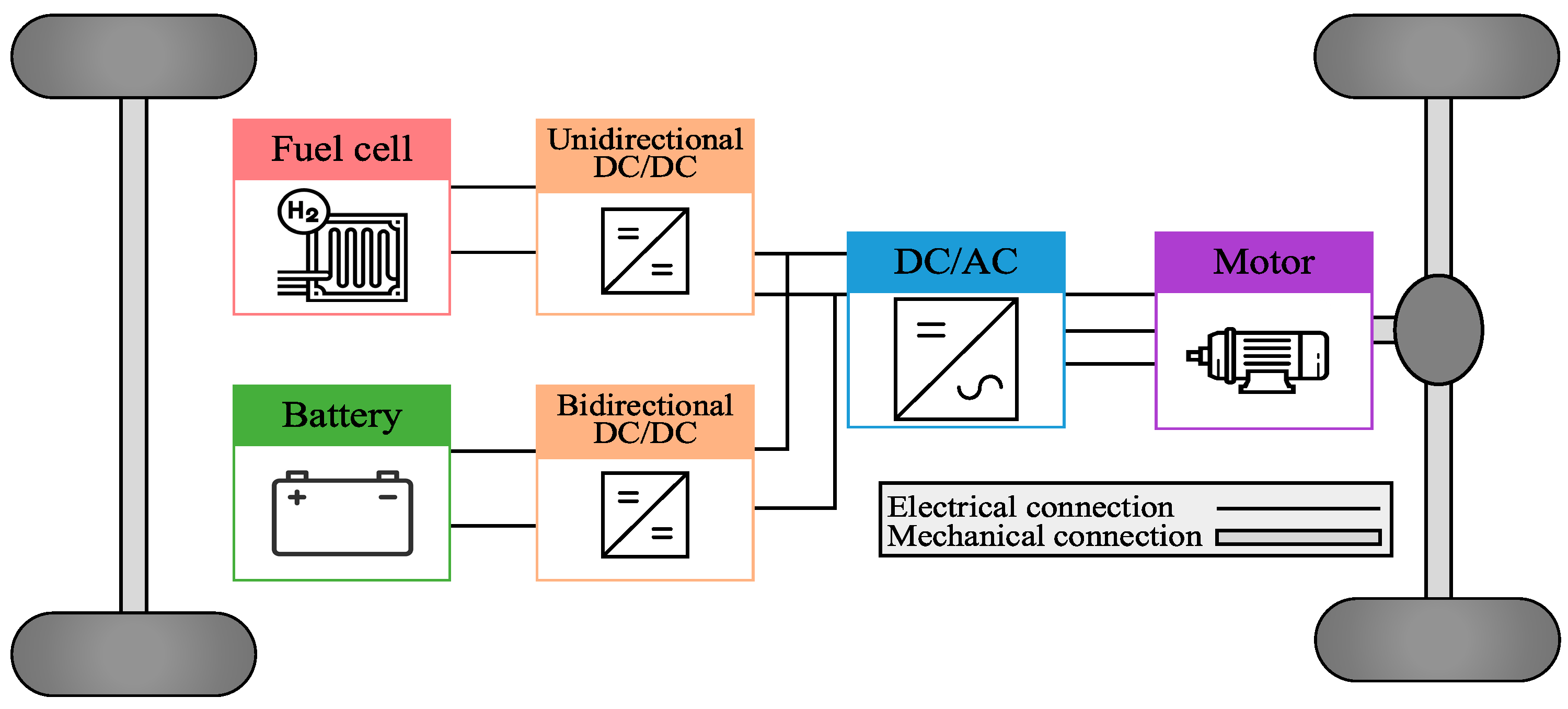
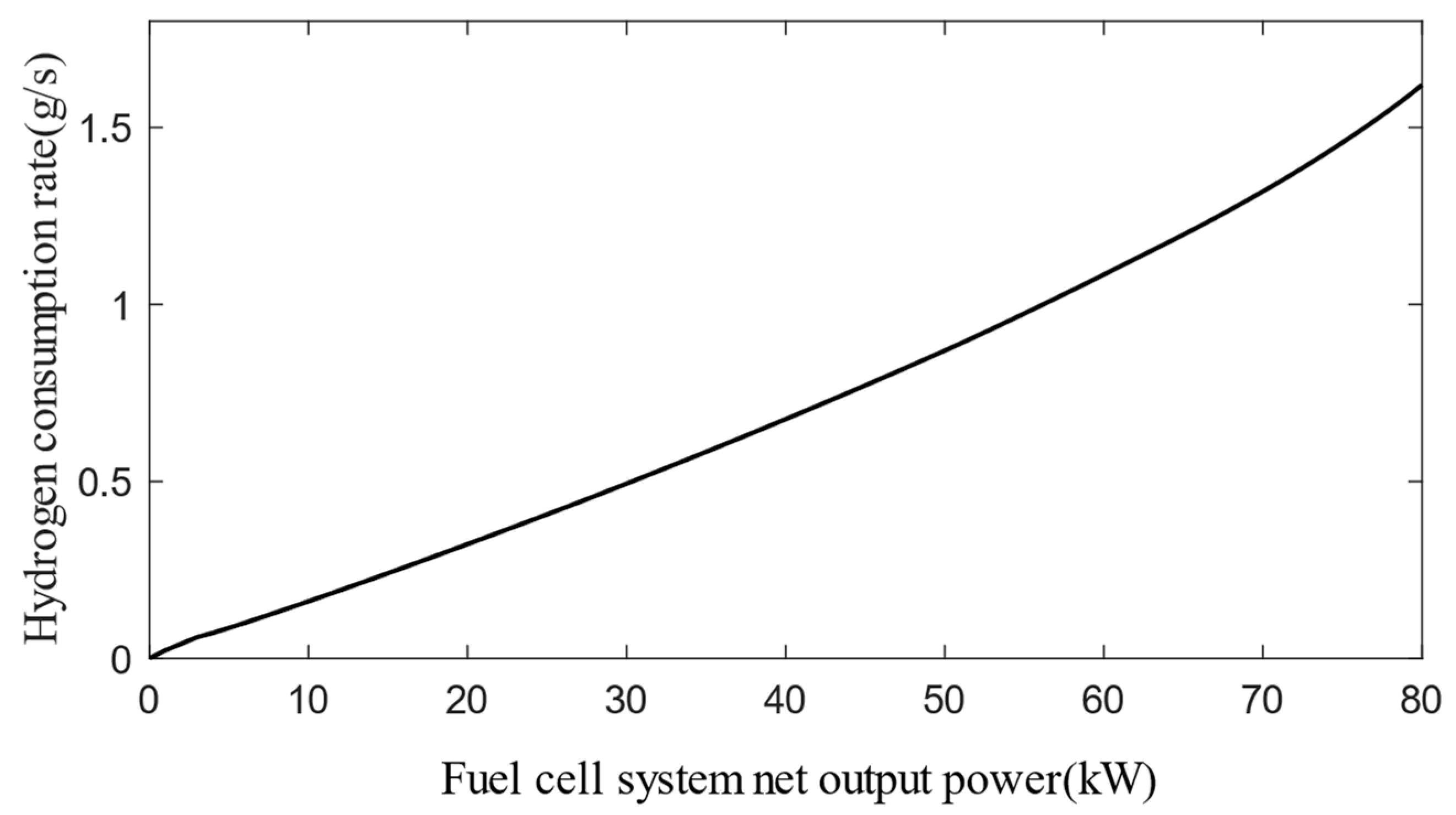
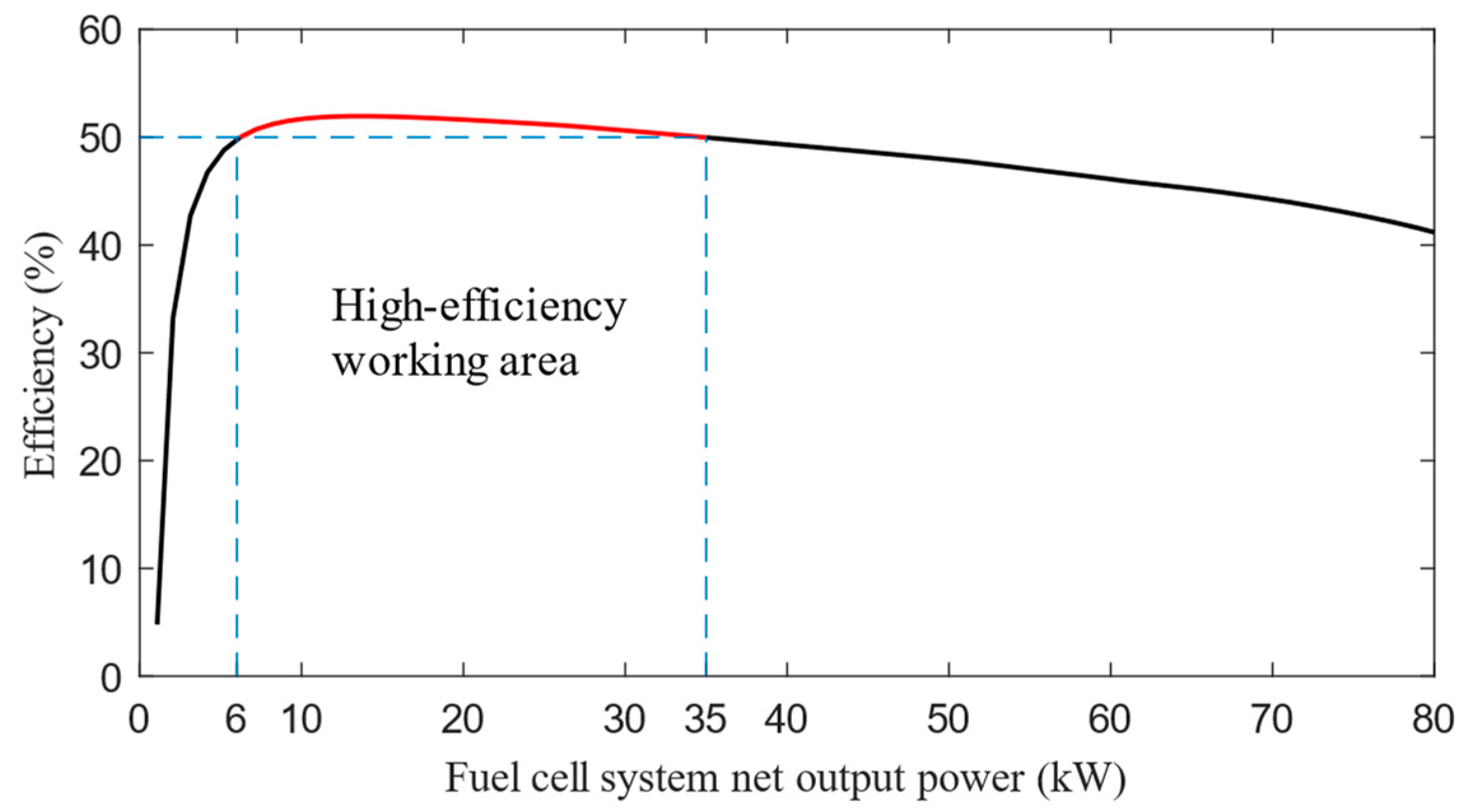
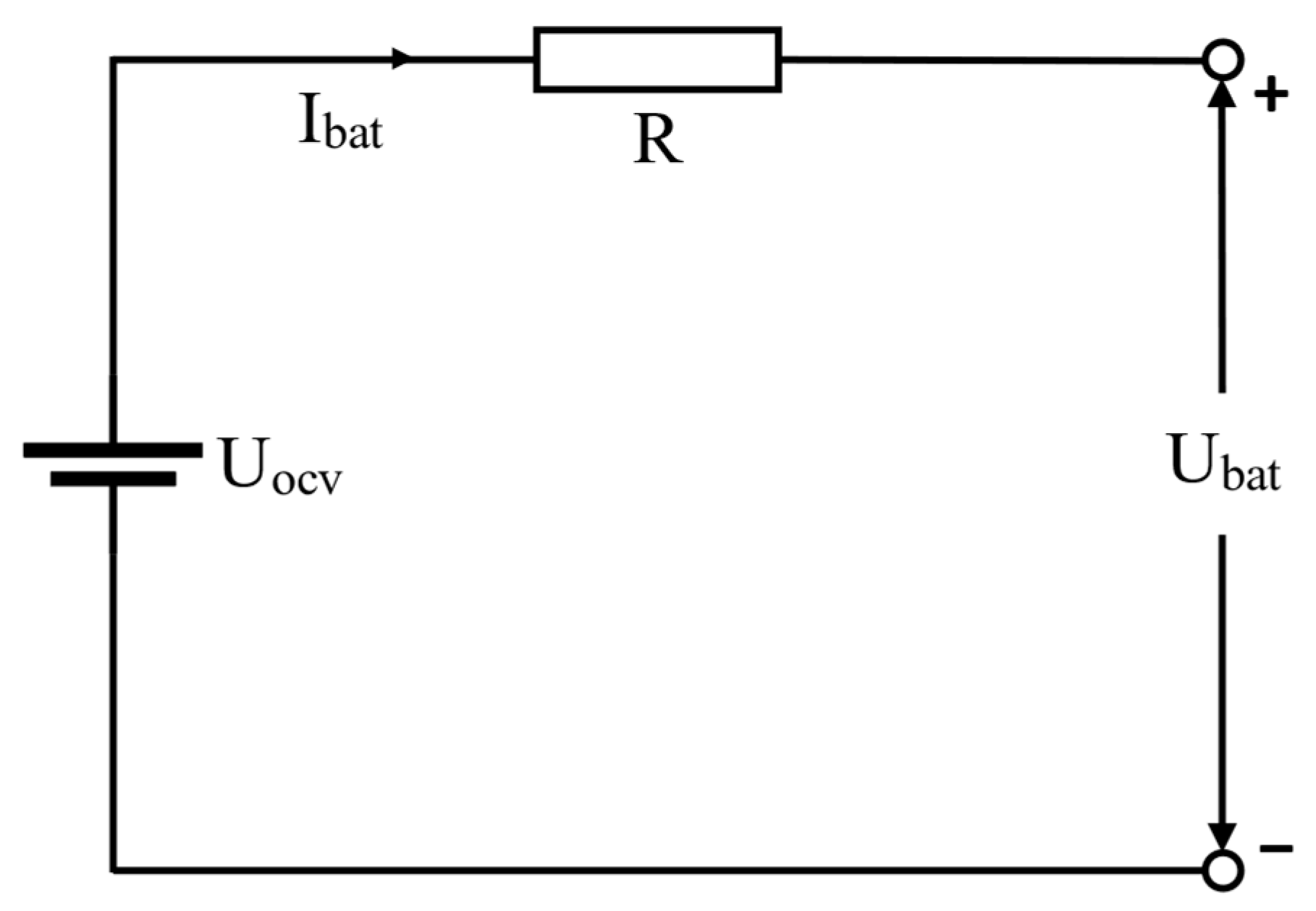
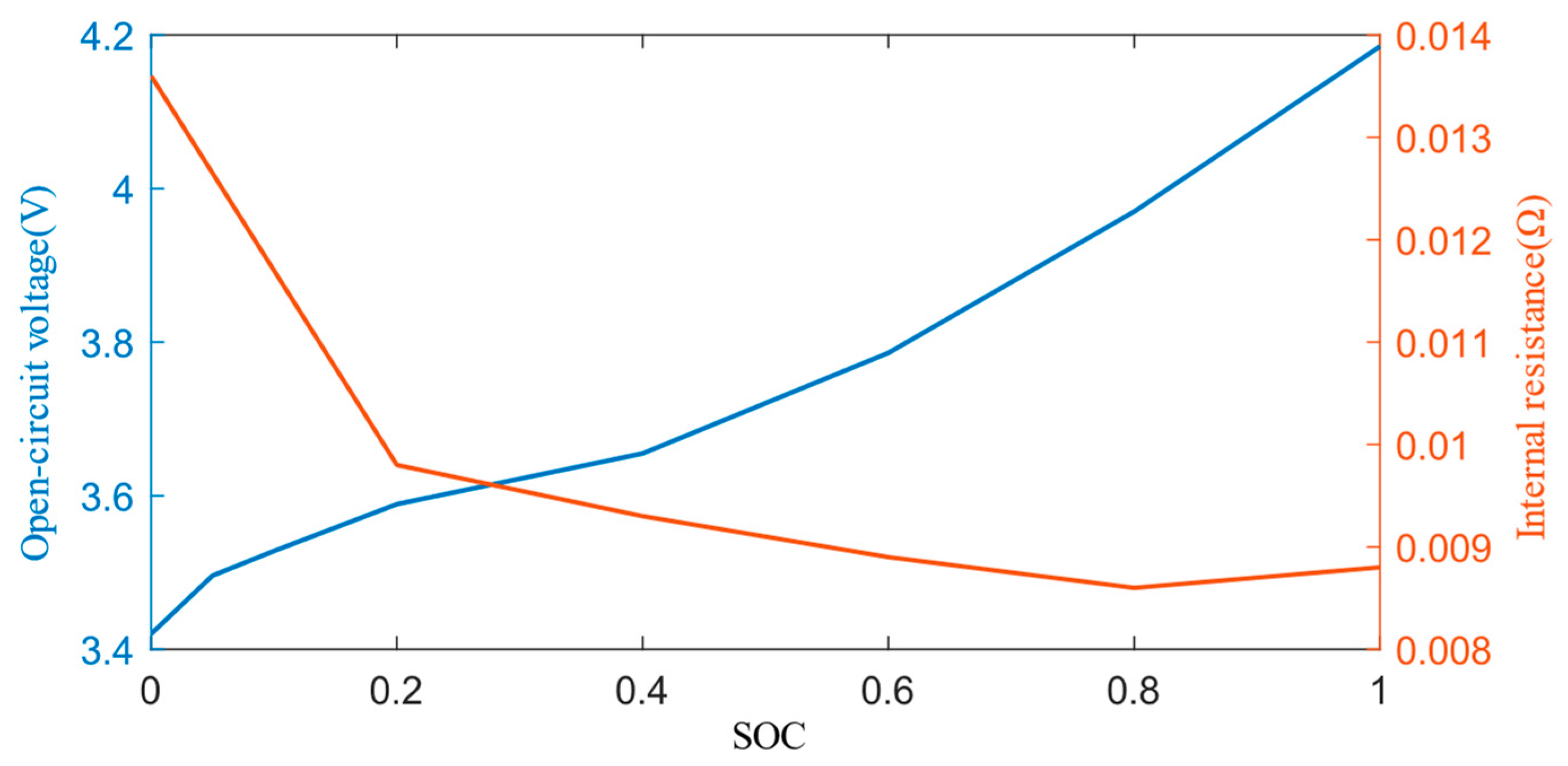
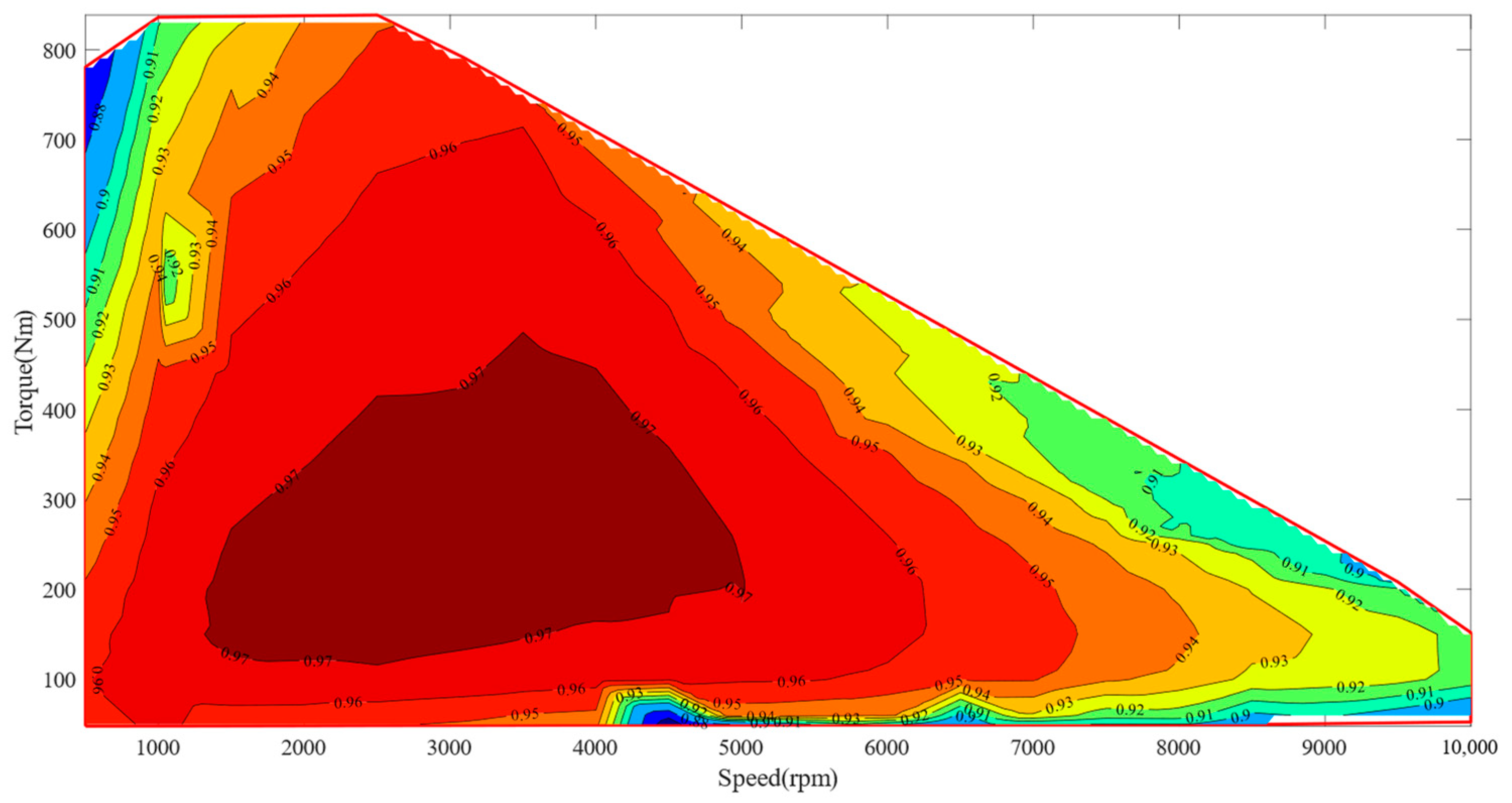


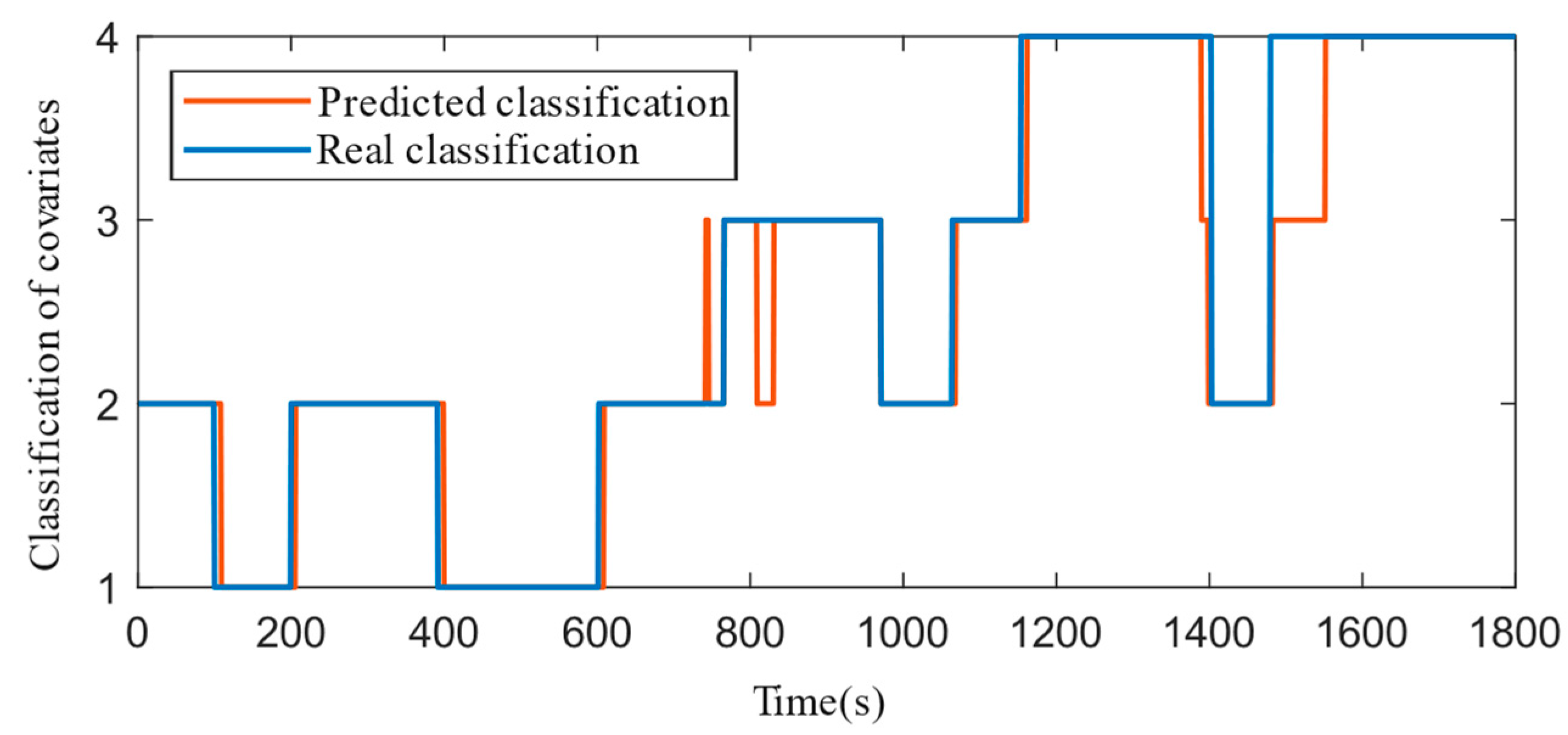
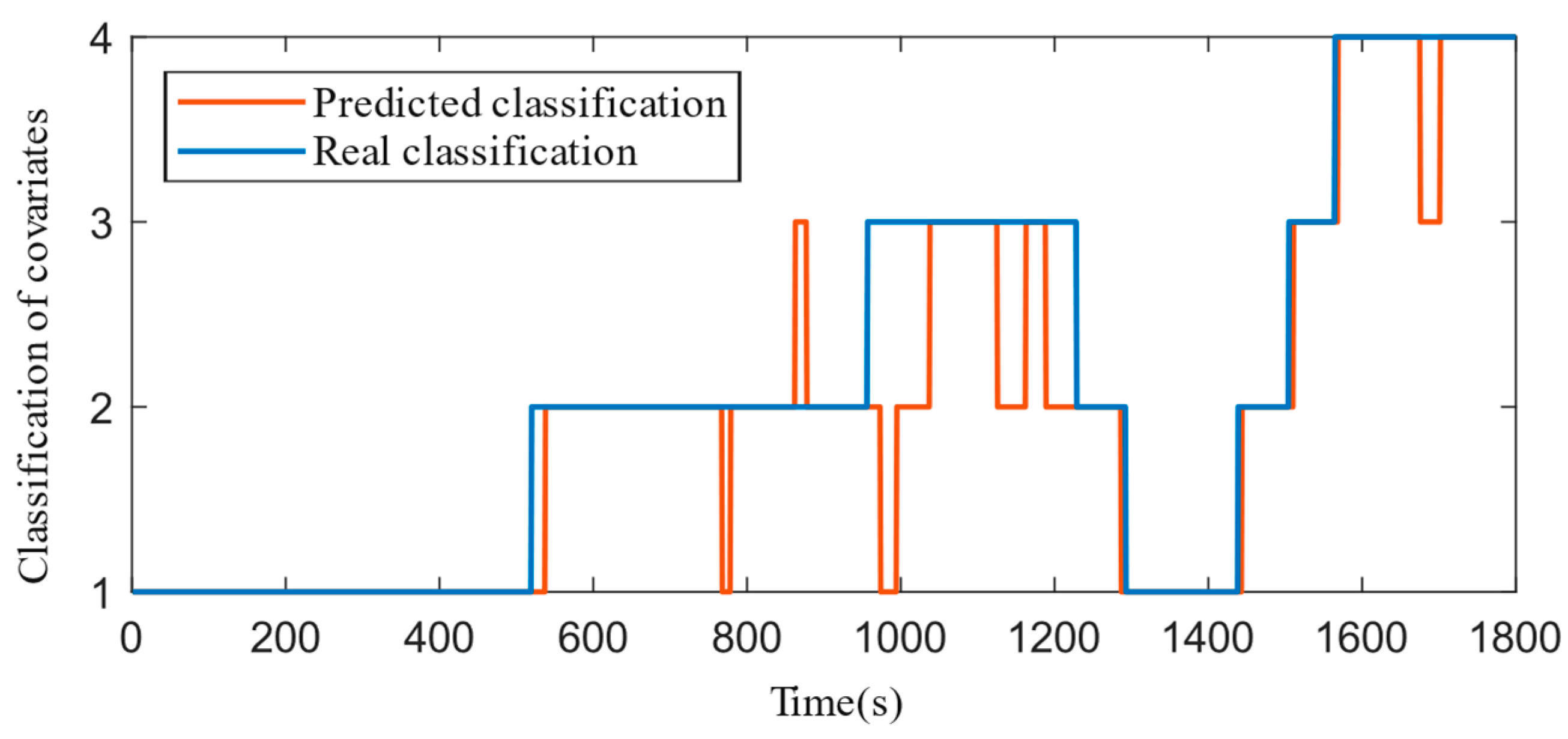
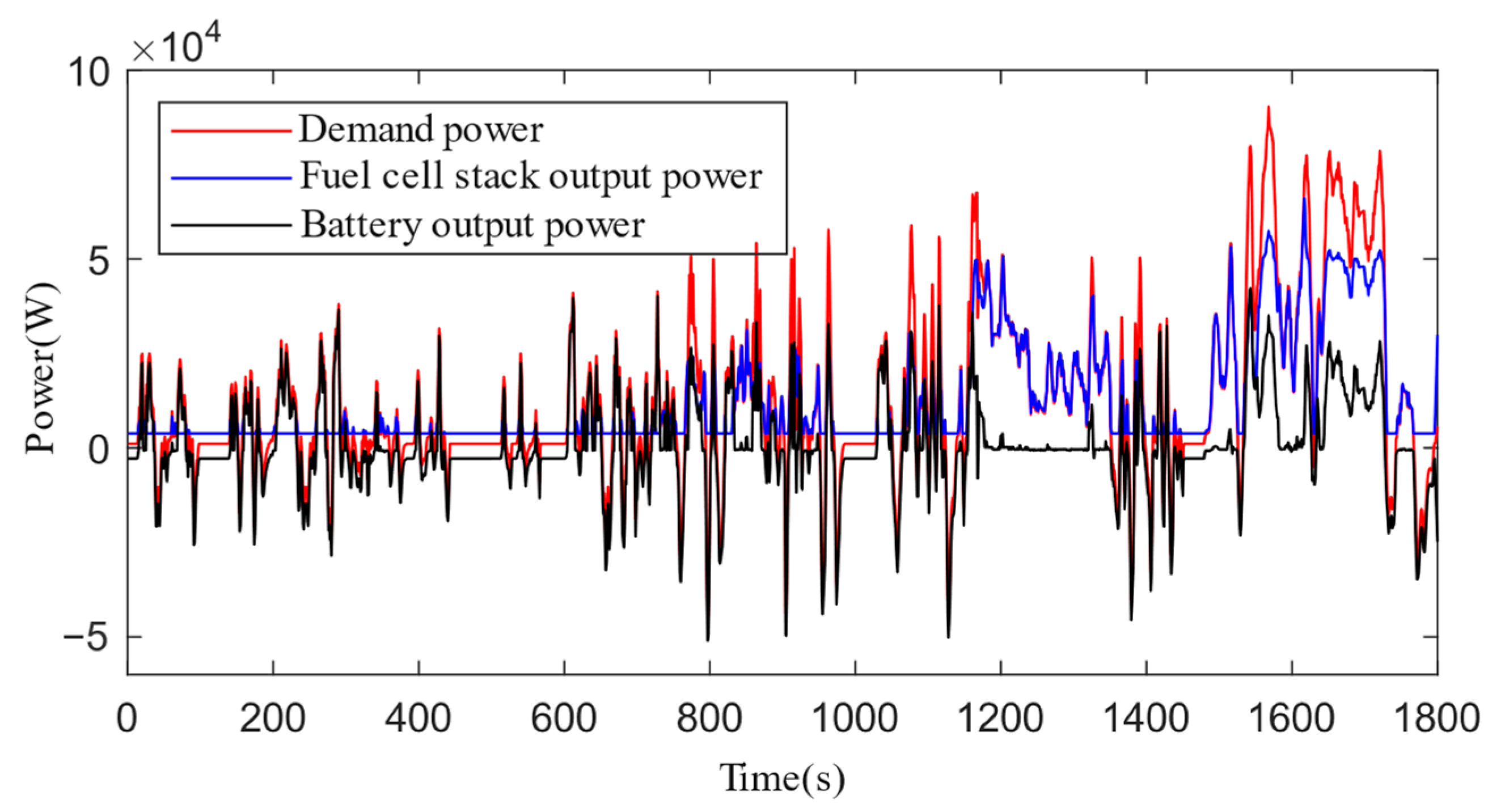





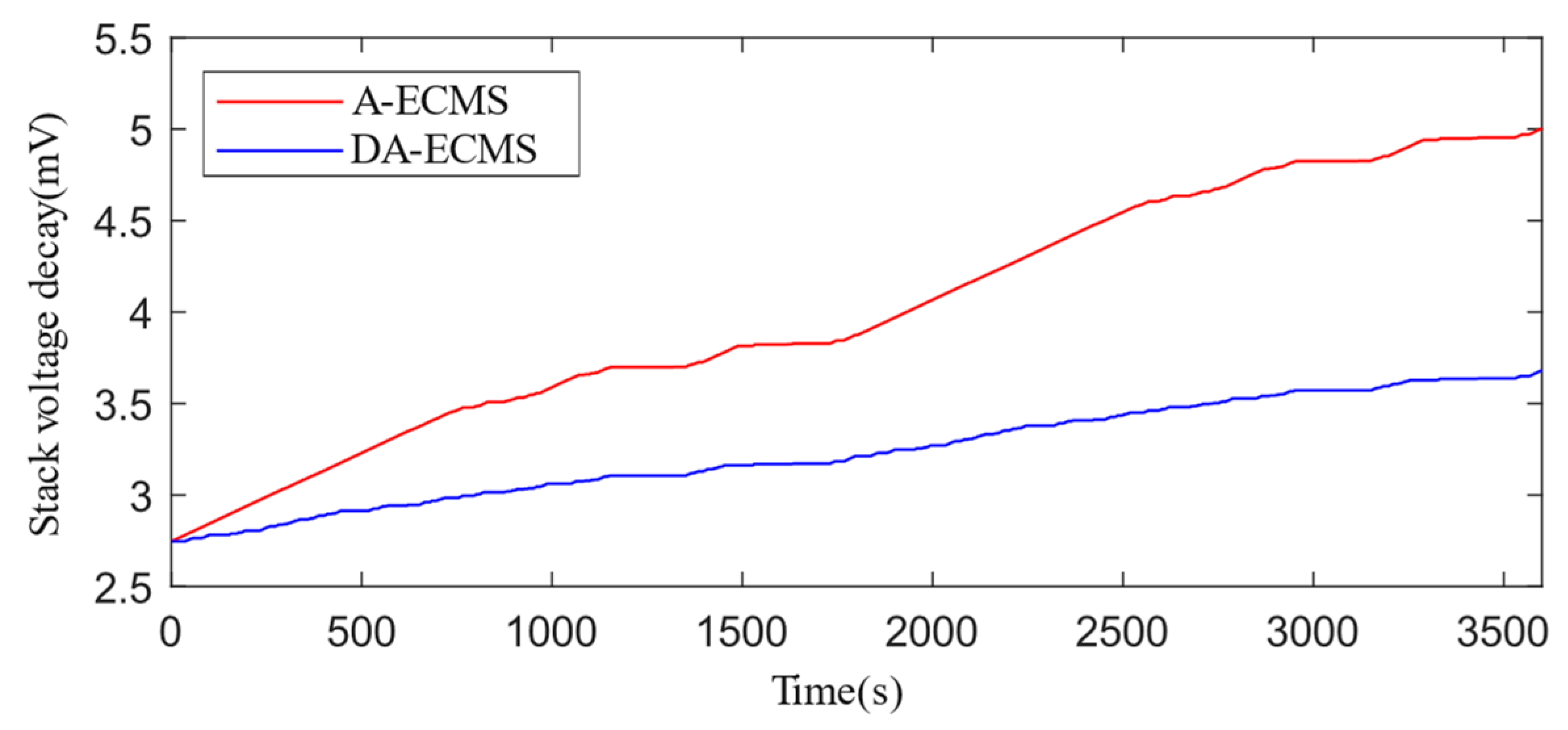
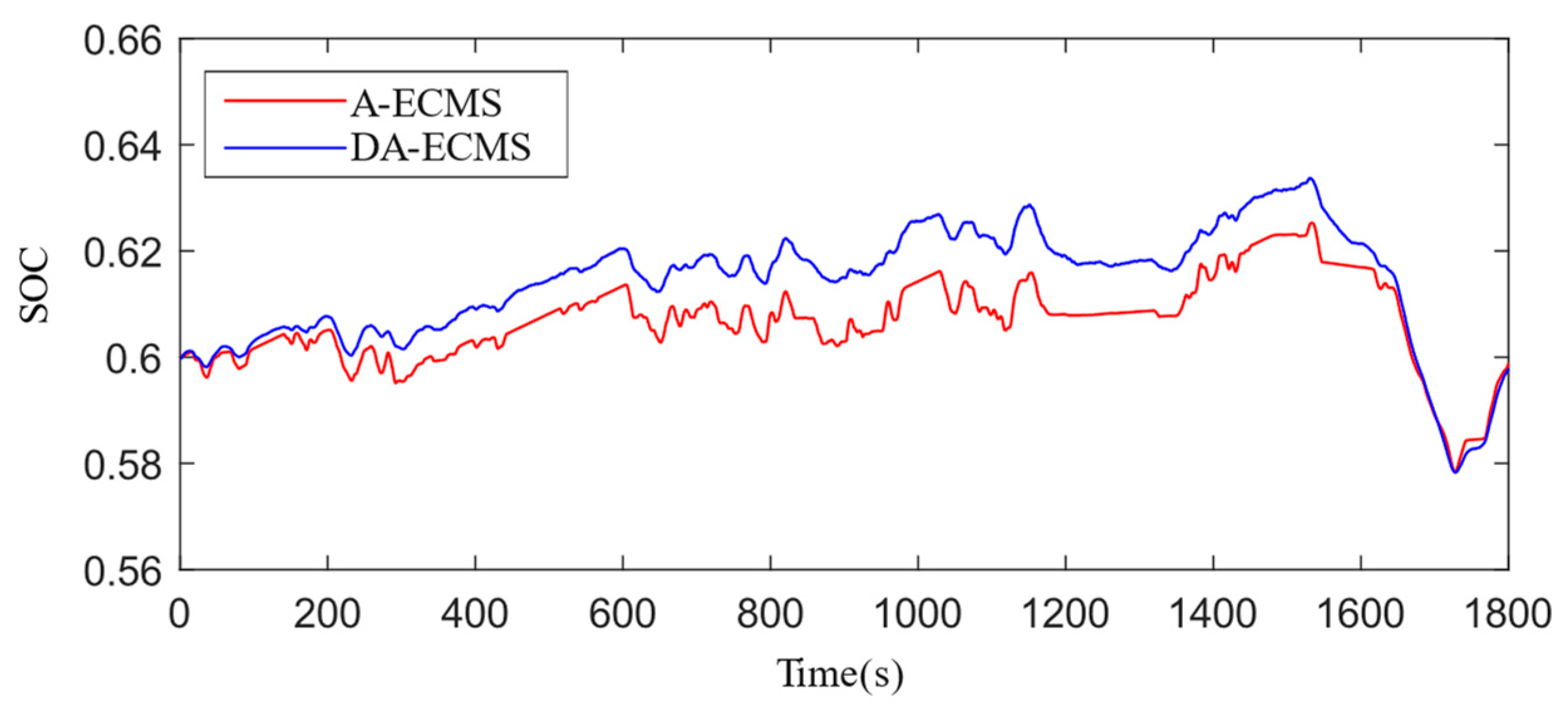
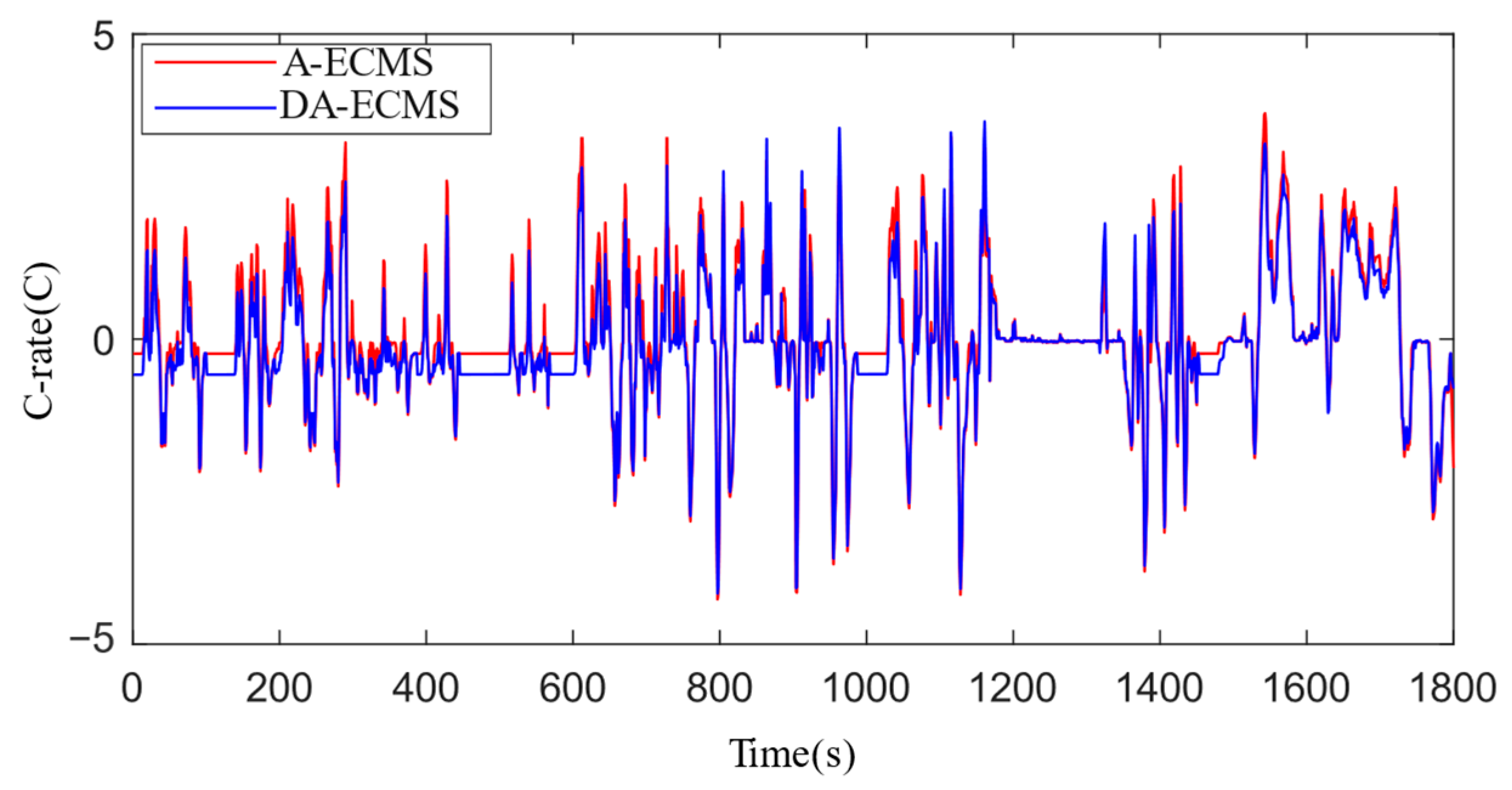
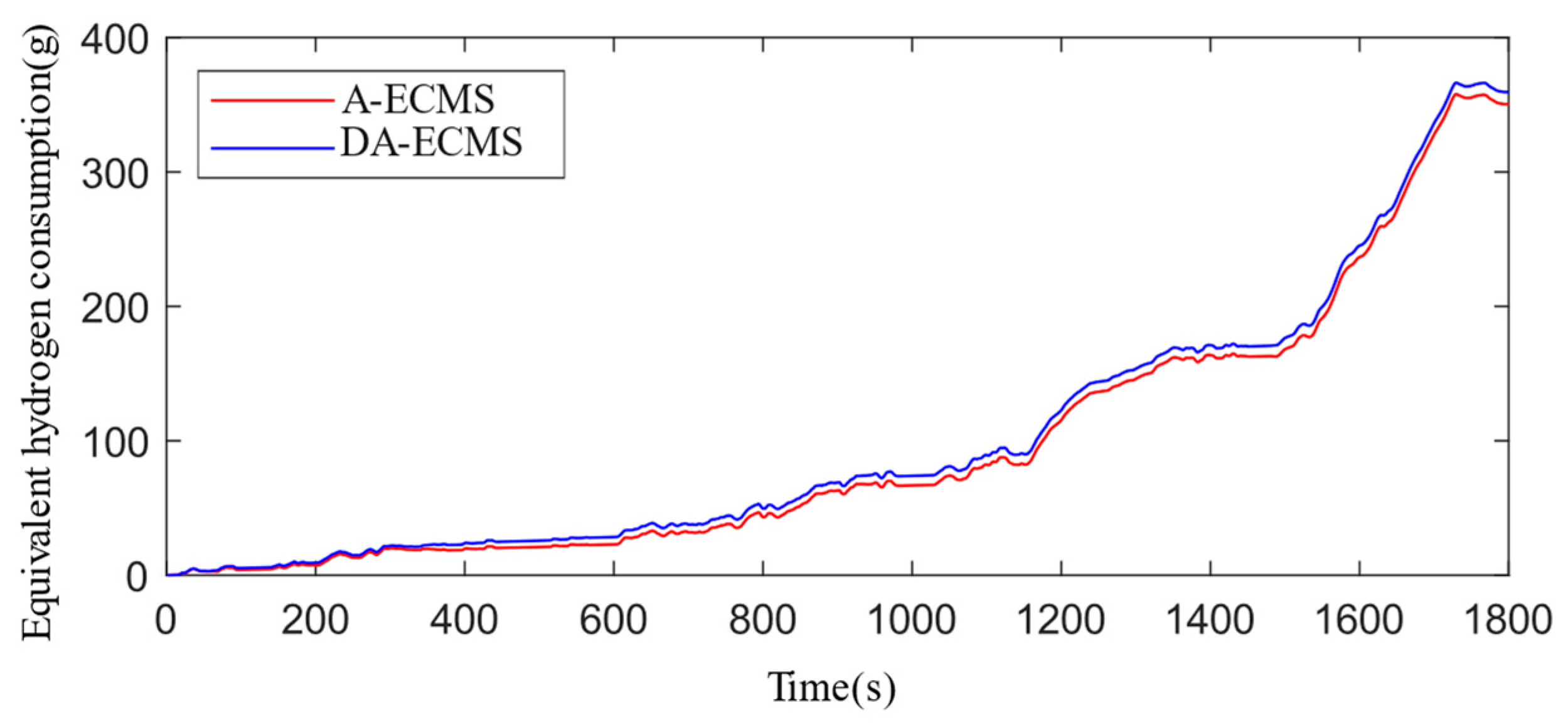
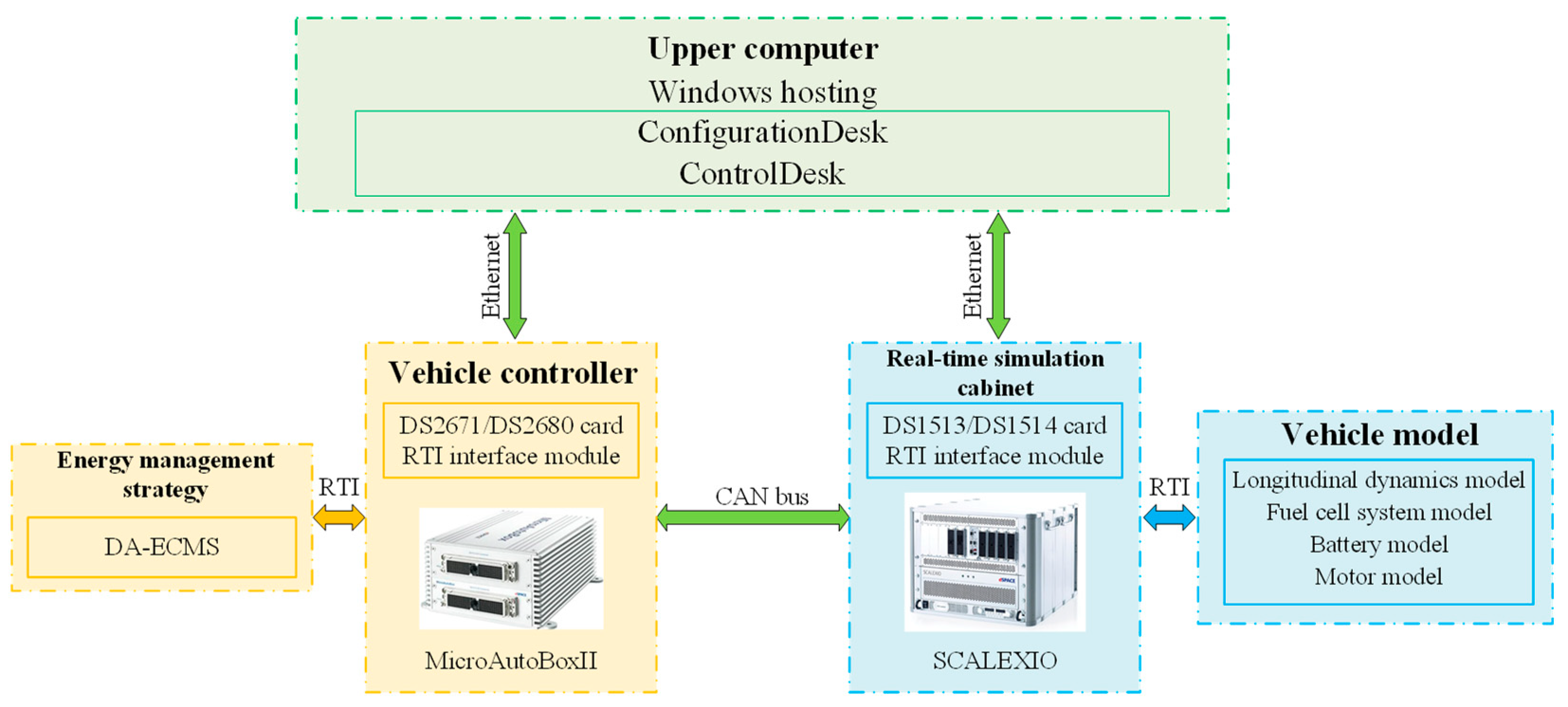
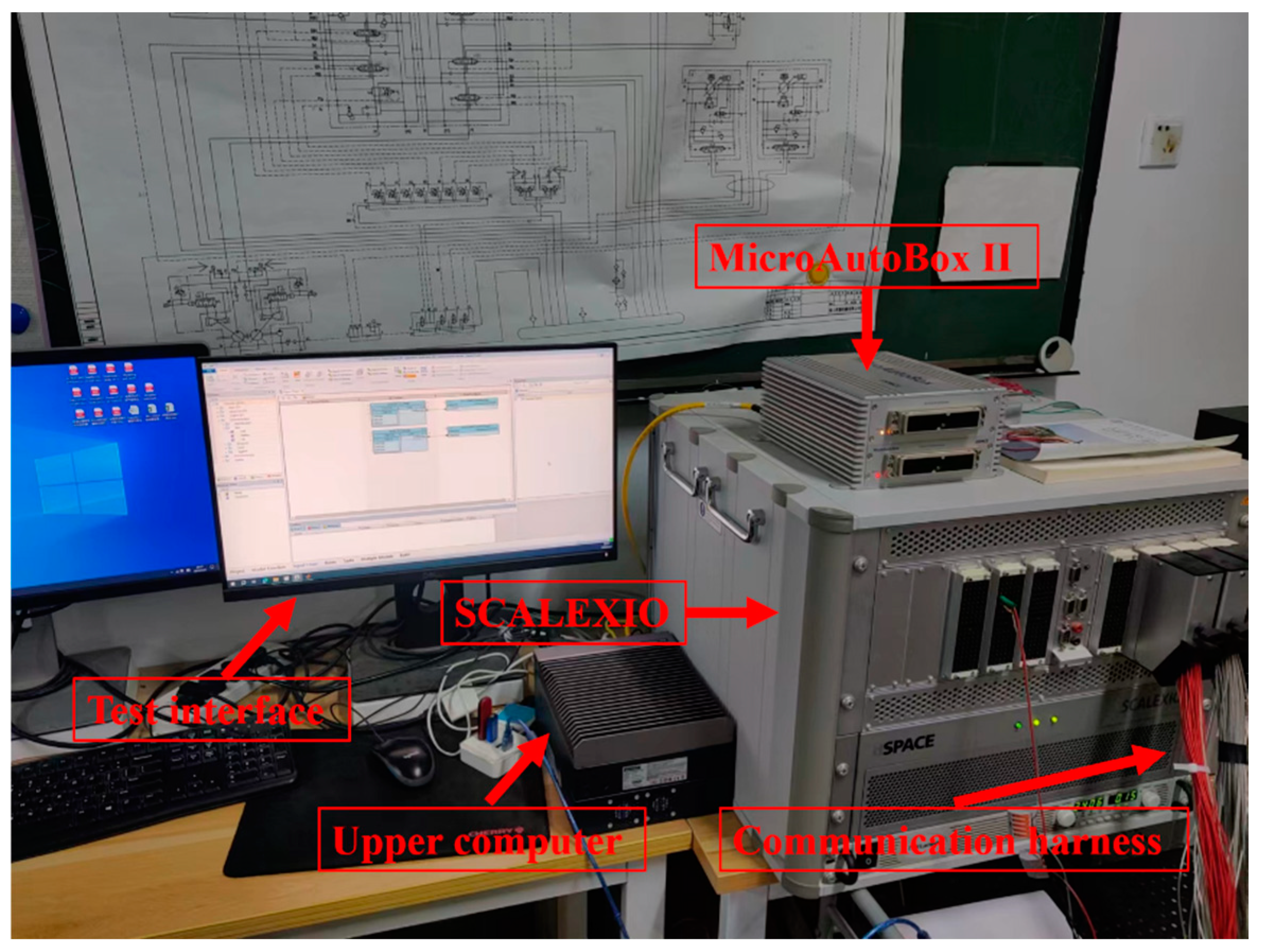
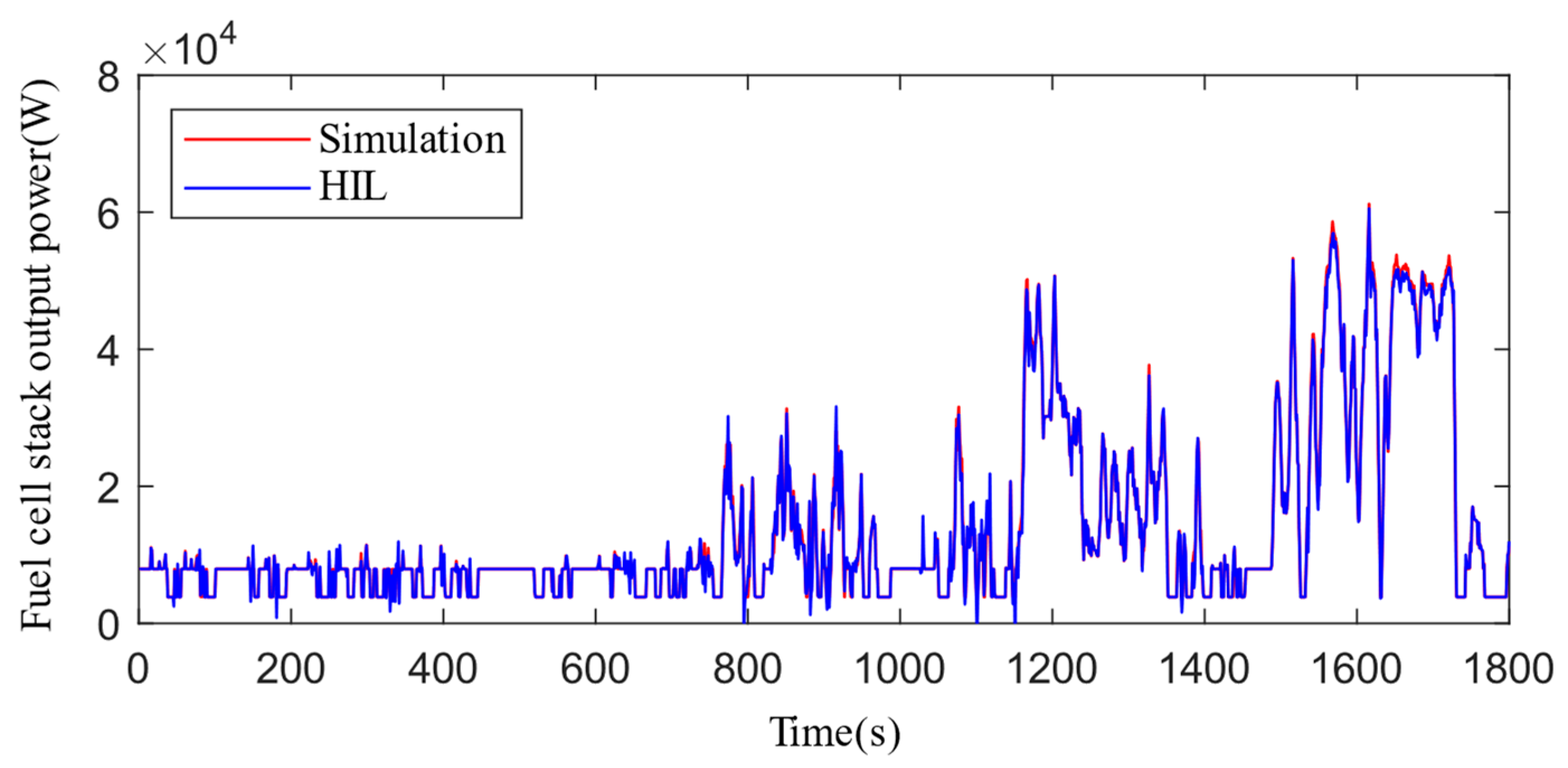
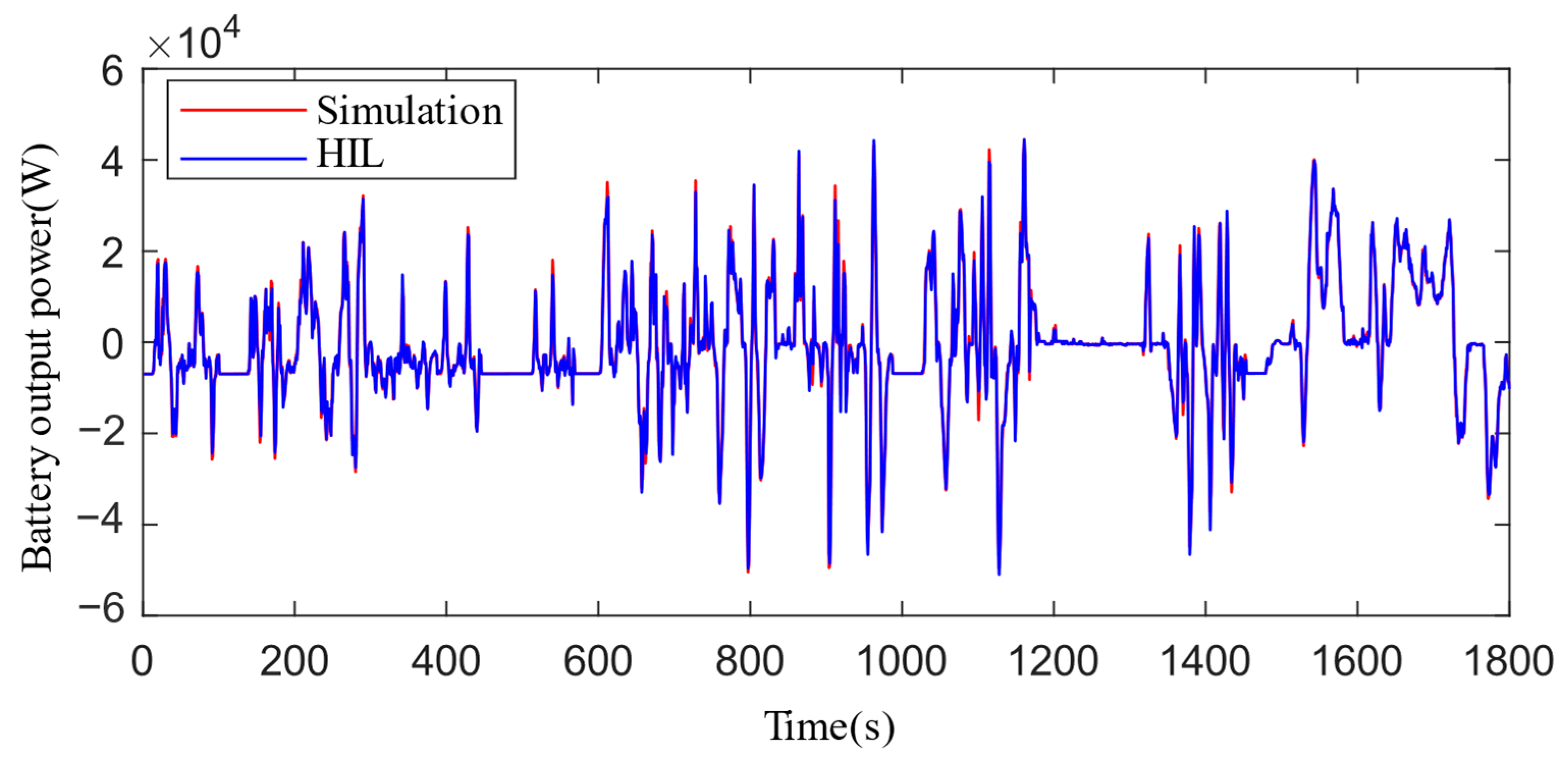
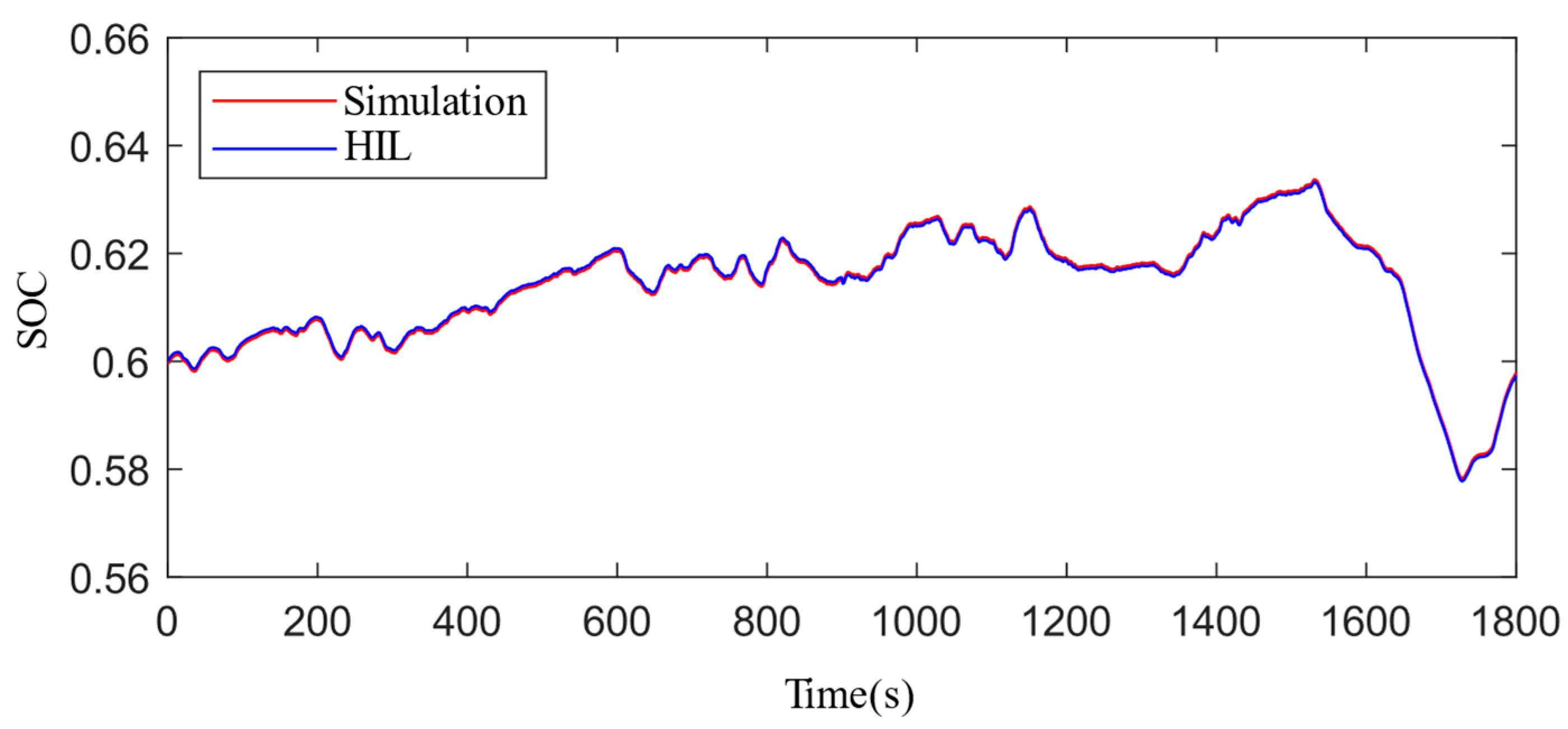

| Component | Parameters | Values |
|---|---|---|
| Vehicle | Mass | 2250 kg |
| Frontal area | 2.88 m2 | |
| Rolling resistance coefficient | 0.009 | |
| Wheel radius | 0.358 m | |
| Fuel cell stack | Nominal power | 80 kW |
| Number of cells | 300 | |
| Battery | Nominal energy | 11.2 kWh |
| Battery capacity | 32 Ah | |
| Number of cells | 96 | |
| Nominal Voltage | 350 V | |
| Motor | Maximum speed | 11,000 rpm |
| Maximum torque | 320 Nm | |
| Unidirectional DC/DC converter | Efficiency | 0.98 |
| Bidirectional DC/DC converter | Efficiency | 0.95 |
| Operating Condition | Voltage Degradation Rate |
|---|---|
| Start-stop | 5.488 μV/cycle |
| Idling | 3.528 μV/h |
| Frequent variable load | 0.166 μV/cycle |
| High load | 4.116 μV/h |
| Parameter | Numerical Value |
|---|---|
| Input number of nodes in layer | 4 |
| Number of hidden layers | 1 |
| Number of hidden layer nodes | 14 |
| Output number of nodes in layer | 4 |
| Learning rate | 0.0001 |
| Maximum number of training cycles | 500 |
| Lot size | 30 |
| Category | Driving Condition | Value of the Optimal Covariate |
|---|---|---|
| 1 | Urban congestion | −201.4 |
| 2 | Urban smooth | −218.2 |
| 3 | Suburban | −224.4 |
| 4 | High speed | −237.6 |
| Energy Management Strategy | Operating Condition | Voltage Degradation (mV/h) | Battery Capacity Degradation 10−3 (%) | Hydrogen Consumption (g/100 km) |
|---|---|---|---|---|
| A-ECMS | WLTP | 7.747 | 26.184 | 1407 |
| CLTC | 8.472 | 16.597 | 979.1 | |
| NEDC | 7.046 | 12.871 | 934.3 | |
| DA-ECMS | WLTP | 6.425 | 24.836 | 1445.6 |
| CLTC | 6.504 | 14.759 | 1044 | |
| NEDC | 5.874 | 11.426 | 1017.5 |
Disclaimer/Publisher’s Note: The statements, opinions and data contained in all publications are solely those of the individual author(s) and contributor(s) and not of MDPI and/or the editor(s). MDPI and/or the editor(s) disclaim responsibility for any injury to people or property resulting from any ideas, methods, instructions or products referred to in the content. |
© 2024 by the authors. Licensee MDPI, Basel, Switzerland. This article is an open access article distributed under the terms and conditions of the Creative Commons Attribution (CC BY) license (https://creativecommons.org/licenses/by/4.0/).
Share and Cite
Zhang, P.; Wang, Y.; Du, H.; Du, C. Health-Conscious Energy Management for Fuel Cell Hybrid Electric Vehicles Based on Adaptive Equivalent Consumption Minimization Strategy. Appl. Sci. 2024, 14, 7951. https://doi.org/10.3390/app14177951
Zhang P, Wang Y, Du H, Du C. Health-Conscious Energy Management for Fuel Cell Hybrid Electric Vehicles Based on Adaptive Equivalent Consumption Minimization Strategy. Applied Sciences. 2024; 14(17):7951. https://doi.org/10.3390/app14177951
Chicago/Turabian StyleZhang, Pei, Yubing Wang, Hongbo Du, and Changqing Du. 2024. "Health-Conscious Energy Management for Fuel Cell Hybrid Electric Vehicles Based on Adaptive Equivalent Consumption Minimization Strategy" Applied Sciences 14, no. 17: 7951. https://doi.org/10.3390/app14177951






